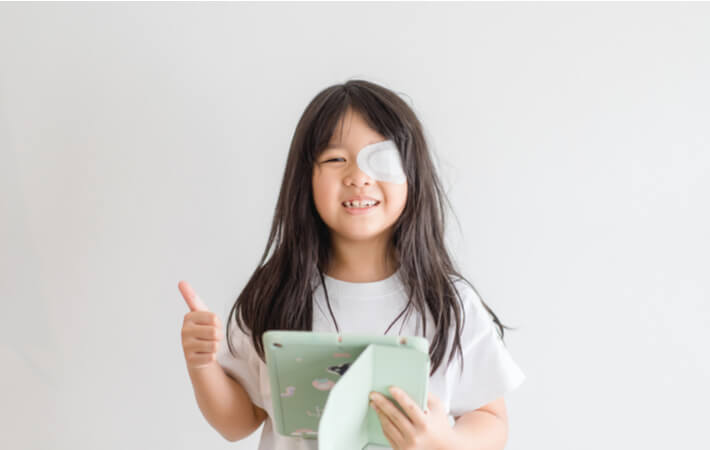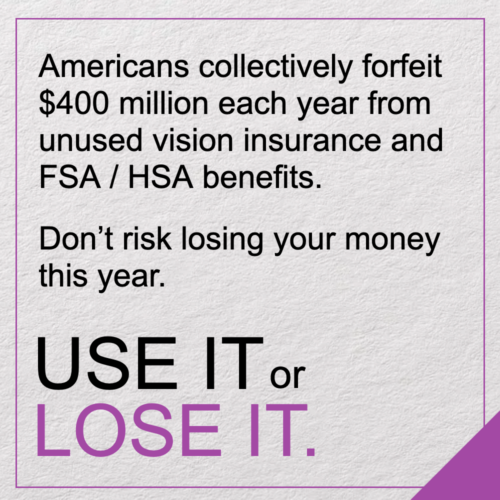Lazy eye is a common condition that can affect vision if not treated properly.
Regular eye exams with the optometrist can help identify and treat conditions like lazy eye early to prevent long-term vision issues from developing. It’s important to take your child in for annual eye exams.
Fortunately, there are many treatments available for lazy eye in children.
Diagnosing Lazy Eye
A comprehensive eye exam can reveal important information about your child’s eye health as a whole while checking for varying prescriptions or any unbalanced movement. Your optometrist may recommend dilation to get a better picture of the inside of the eye.
The method of diagnosis depends on the age of the child. For children under 3 years old, the optometrist will likely use a lighted magnifying device to look for any signs of disease and other simple tests to examine your child’s ability to focus and fix their gaze.
For children older than 3 years, tests using pictures of letters can be used to assess their vision. A refractive assessment will also be completed to determine the focusing capacity of each eye.
Understanding Amblyopia
Lazy eye, also known as “amblyopia”, usually occurs in early visual development and is characterized by one eye “wandering”, or failing to work with the other eye. Lazy eye can cause reduced vision and develops until the child is about 7 years old.
A common misconception about lazy eye is that it’s always noticeable. Some children may have amblyopia, but their eyes appear to be “normal”. Lazy eye is more than a difference in how an eye may look—it can cause serious visual issues if left untreated.
Causes of Lazy Eye
Lazy eye can occur as a result of abnormal visual experiences early in life. Anything that blurs a child’s vision, or crosses their eyes, can cause lazy eye. The primary causes of lazy eye include:
- Deprivation
- Muscle imbalance
- Varying focus capacity between the eyes
Signs & Symptoms
Early diagnosis can help prevent long-term issues. The signs and symptoms of lazy eye include:
- Head tilting
- Wandering eye
- Poor depth perception
- Irregular vision test results
- Squinting or shutting the affected eye
If you notice any of these symptoms in your child, regardless of their age, take them to an optometrist to discuss potential causes and treatments.

Treating Lazy Eye
Early treatment is critical in correcting lazy eye.
Connections between the eye and brain are beginning to form during childhood which can be encouraged with early treatment. This can help encourage healthy connections to develop.
The best results occur when treatment begins before the child is 7 years old. However, treatment can still be effective until your child is 17 years old. The fact remains that the most effective treatments are done when your child is younger. Scheduling and attending regular eye exams is key to getting early treatment.
There are many treatments available, and choosing the right treatment for your child can be done with the help of your optometrist.
Activities
Activity-based treatments are also available, such as puzzles, games, and drawing. These activities are likely more effective when combined with additional treatments, but nothing has been definitively proven.
Bangerter Filter
A Bangerter filter is specially designed to blur the vision of the unaffected eye. This filter is laid over an eyeglass lens, working similarly to an eye patch, and stimulates the lazy eye.
Corrective Eyewear
Glasses and contact lenses can help correct refractive errors that can lead to lazy eye. This includes myopia (nearsightedness), hyperopia (farsightedness), and astigmatisms. This is typically the easiest option.
Eye Drops
Atropine, or “Isopto Atropine”, is a medicated eye drop that can temporarily blur vision in the unaffected eye. This is an alternative to a patch or filtered lens and stimulates the lazy eye.
Eye Patches
Your optometrist may recommend wearing an eye patch over your child’s unaffected eye. This technique helps stimulate the lazy eye over a 2 to 6 hour period, gradually correcting the lazy eye.
Surgery
Depending on the severity of the lazy eye, your optometrist may recommend surgery to correct the lazy eye. If your child has drooping eyelids or cataracts, this can cause deprivation amblyopia and requires prompt treatment.
If your child’s eyes begin to cross or wander despite corrective strategies, surgery may be the next step.
Is It Too Late to Treat Lazy Eye?
Once a person reaches 18 – 20 years of age, it may indeed be too late to treat lazy eye with one of the easier methods, and they’ll likely need a different type of treatment to address the problem. This doesn’t mean it’s too late, but you will have to talk to your optometrist about the right option for you and your health.
Next Steps
Most children with lazy eye notice a difference within the first few weeks to months of treatment. It’s important to monitor your child’s eyes and progression as they undergo treatment. Lazy eye can recur, which requires restarting treatment.
For more information about treatment options and to book an appointment, please contact our team to get set up with our San Mateo optometrist for a consultation.




